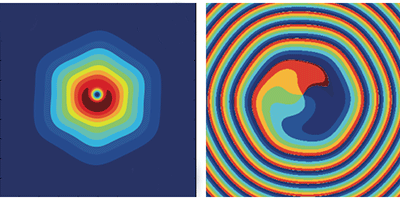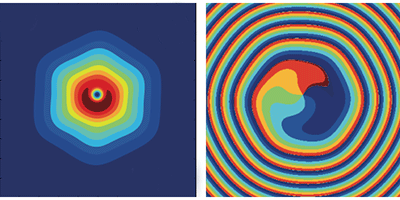Spinning a Condensate with Light
The collective quantum state called a Bose-Einstein condensate was first created using ultracold atoms, and it has recently been demonstrated using composite particles in specialized semiconductor structures. These semiconductor-based versions form at higher temperatures and could potentially be used for sensitive detectors or novel optoelectronic devices, but they are harder to manipulate directly. Now an international team led by Elena Ostrovskaya of the Australian National University in Canberra has shown how a patterned light source can modify the internal state of the condensate, specifically by giving it a net rotation.
To form a condensate, researchers employ semiconductor microcavities that confine both light and light-generated electron-hole pairs to form combined “exciton-polaritons.” If the light is bright enough to create a high density of these quasiparticles, they can spontaneously form a condensate, even at temperatures approaching room temperature. But the detailed wave information in the light is lost in making the pairs, and thus cannot be used to tailor the condensate’s properties as is done in atomic systems.
The new experiments exploited the natural motion of newly generated pairs toward bright regions where other pairs have already condensed. By patterning the illumination in an asymmetrical spiral pattern, the researchers used this quasiparticle flow to impart angular momentum to the entire condensate, which they confirmed by measuring the phase variation of the luminescence it emitted. Among other applications, the circulating condensate might be useful for devices reminiscent of existing SQUID detectors, which use circulating electric currents in superconductors to measure tiny magnetic fields.
This research is published in Physical Review Letters.
–Don Monroe





